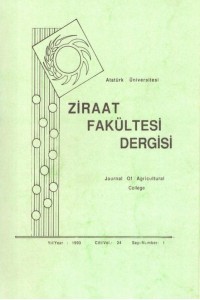AYNI YAŞTAKİ DİŞİ GÖKKUŞAĞI ALABALIKLARI (Salmo gairdnerii R.) İLE FARKLI YAŞLARDAKİ ERKEK BALIKLAR ARASINDA YAPILAN ÇİFTLEŞTİRMENİN BAZI ÜREME ÖZELİKLERİNE VE YAVRULARIN BÜYÜMELERİ ÜZERİNE ETKİLERİ
Öz
ÖZET
Bu araştırmada, aynı yaşlardaki (5 yaş) dişi damızlık Gökkuşağı
alabalıklarıyla (Salmo gairdnerii R.) çiftleştirilen genç (2 yaş) ve yaşlı (5 yaş) erkek
damızlık balıklardan elde edilen yumurtaların döllülük nisbeti, çıkış gücü, embriyo
dönemi yaşama gücü, keseli dönemde yaşama gücü ve kuluçka randımanları ile
yavruların gelişme performansları karşüaştırümıştır.
Kuluçka döneminde genç erkek x yaşlı dişi grubunda döllülük nisbeti %
95.47, embriyo dönemi yaşama gücü % 93.99, çıkış gücü % 98.43, keseli dönemde
yaşama gücü % 98.13 ve kuluçka randımanı ise % 93.98 olarak tesbit edilmiştir.
Yaşlı erkek x yaşlı dişi grubunda ise, döllülük nisbeti % 85.36, embriyo dönemi
yaşama gücü % 79.75, çıkış gücü % 94.47, keseli dönemde yaşama gücü % 95.12 ve
kuluçka randımanı % 81.07 olarak belirlenmiştir. İki grup arasında incelenen bütün
parametreler arasında istatistiki olarak önemli farklar meydana gelmiştir (P<0.05).
Besi denemesi süresince genç erkek x yaşlı dişi grubunda ortalama canlı
ağırlık artışı 0.2 g'dan 1.8365 g.a', yaşlı erkek x yaşlı dişi grubunda ise 0.1975
g'dan 1.8435 g'a yükselmiştir. Ayrıca, her iki grup için ortalama canlı ağırlık artışı
0.19875 g'dan 1.84 g'a ulaşmıştır. Canlı ağırlık artışı yönünden, gruplar arasında
fark bulunamamıştır (P>0.05).
Genç erkek x yaşlı dişi grubunda yem değerlendirme katsayısı 3.68, yaşlı
erkek x yaşlı dişi grubunda ise 3.47 olarak bulunmuştur. Ortalama yem değerlendirme
katsayısı ise, her iki grup için 3.575 olarak hesaplanmıştır. Yem değerlendirme
katsayısı yönünden, gruplar arasındaki fark istatistiki olarak önemsizdir (P>0.05).
Besi denemesi sonunda, genç erkek x yaşlı dişi grubu yavrularının ortalama
yaşama gücü % 945, yaşlı erkek x yaşlı dişi grubunda ortalama yaşama gücü ise %
93.8 olarak bulunmuştur. Bu özellik bakımından da gruplar arasında fark
görülmemiştir (P>0.05).
Sonuç olarak, genç erkek, yaşlı dişi grubu kuluçka döneminde incelenen
Özellikler bakımından, yaşlı erkek x yaşlı dişi grubundan daha üstün bulunmuştur.
Besi döneminde ise, canlı ağırlık artışı, yem değerlendirme katsayısı ve yaşama gücü
bakımından gruplar arasında önemli farklılıklar görülmemiştir (P>0.05).
THE EFFECTS OF THE MATINGS OF THE SAME AGED FEMALES
AND THE DİFFERENT AGED MALES OF THE RAİNBOVV TROUT
(Saimo gairdnerii R.) ON SOME REPRODUCTIVE TRAITS AND
THE GROWTH OF OFFSPRINGS
SUMMARY
In this study, the same aged females (5 years old) of the
rainbow trout (Saimo gairdnerii R.) were mated with the young (2 years old) and the
old (5 years old) males fishes. This two groups vvere compared with each other in
regard to the percentage of the fertilized eggs, hatching rate, embriyonical survival
rate, the hatching yield and the growth performances of the fıngerlings.
İn the hatehery period the percentage of the fertilized eggs, the embriyonical
survival rate, the hatching rate, the survival rate of the larvae and the hatching yield
were calculated as 95.47 %, 93.99 %, 98.43 %, 98.13 % and 93.98 % in the fırst
group (male young fish xfamale old fish) respeetively. In the second group (male old
fish xfamale old fish) the percentage of the fertilized eggs, the embriyonical survival
rate, the hatching rate, the survival rate of the larvae and the hatching yield were
fonud 85.36 %, 79.75 %, 94.47 %, 95.12 % and 81.07 % respeetively. The
differences between two groups for ali parameters examined in this experiment were
found statistically important (P<0.05).
During thefeeding experiment, the average live we'ıght gains reached from 02
g to 1.8365 g. in the fırst group (male young fish xfamale old fish) and from 0.1975
g to 1.8435 g in the second group ( male old fish xfamale old fish). The differences
in respect to the live weight gain were not found between two groups (P>0.05).
The coefficients of the feed conversion were found as 3.68 and 3.47 in the
fırst and in the second group, respeetively. The differences for the coefficient of the
feed conversion were statistically not found between two group.
At the and of thefeeding experiment the mean survival rate of the young fishes
were found as 94.50 % and 93.8 % in the first and in the second group, respeetively.
The types of the mating have no effect on the survival rate of the fıngenling (P>0.05).
As a resuit, the fîst group (male young fish x famale old fish) for ali hacthery
caracteristics is superior than the second group (male old fish x famale old fish). But,
in the feeding period, the types of the mating have no significantly effected (P>0.05)
the live weight gain, the food conversion rate and the survival rat
Anahtar Kelimeler
Ayrıntılar
| Birincil Dil | tr;en |
|---|---|
| Bölüm | ARAŞTIRMALAR |
| Yazarlar | |
| Yayımlanma Tarihi | 3 Ocak 2011 |
| Yayımlandığı Sayı | Yıl 1993 Cilt: 24 Sayı: 1 |
Kaynak Göster
Bu dergide yayınlanan makaleler Creative Commons Uluslararası Lisansı (https://creativecommons.org/licenses/by-nc/4.0/) kapsamında yayınlanmaktadır. Bu, orijinal makaleye uygun şekilde atıf yapılması şartıyla, eserin herhangi bir ortam veya formatta kopyalanmasını ve dağıtılmasını sağlar. Ancak, eserler ticari amaçlar için kullanılamaz.
https://creativecommons.org/licenses/by-nc/4.0/

